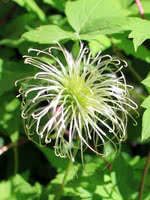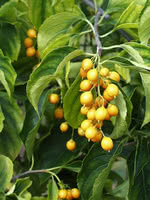Mon-Fri 9am - 5pm Mountain time
Blue Virginsbower Clematis vs American Bittersweet
Clematis occidentalis
Celastrus scandens
CUSTOM GROW
NOT AVAILABLE THIS SEASON - MIGHT RETURN
Blue Virginsbower Clematis is a species of flowering plant from the buttercup family. This plant is native to North America and is commonly used in gardens and landscaping. This plant varies in appearance but generally produces vines and climbs surfaces. Blue Virginsbower Clematis produces deep purple-blue flowers and green leaves that are divide into three thick leaflets.
American Bittersweet is a deciduous, woody, perennial vine with striking orange to yellow berries that persist into winter. Indigenous to North America, this vine has become so rare it is now considered a protected species.
Excellent for naturalization projects, American Bittersweet attracts birds and other wildlife. Please keep in mind that the plant is toxic to humans and should not be ingested. To ensure the attractive berries are produced, cross-pollination between a male and female plant must occur.

